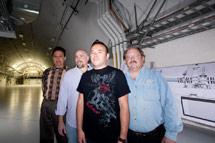
Handy Links
SLAC News Center
SLAC Today
- Subscribe
- Archives: Feb 2006-May 20, 2011
- Archives: May 23, 2011 and later
- Submit Feedback or Story Ideas
- About SLAC Today
SLAC News
Lab News
- Interactions
- Lightsources.org
- ILC NewsLine
- Int'l Science Grid This Week
- Fermilab Today
- Berkeley Lab News
- @brookhaven TODAY
- DOE Pulse
- CERN Courier
- DESY inForm
- US / LHC
SLAC Links
- Emergency
- Safety
- Policy Repository
- Site Entry Form

- Site Maps
- M & O Review
- Computing Status & Calendar
- SLAC Colloquium
- SLACspeak
- SLACspace
- SLAC Logo
- Café Menu
- Flea Market
- Web E-mail
- Marguerite Shuttle
- Discount Commuter Passes
-
Award Reporting Form
- SPIRES
- SciDoc
- Activity Groups
- Library
Stanford
Around the Bay
Where the LCLS Ends: The XCS Instrument
The Linac Coherent Light Source will pack a wallop. When it begins operation later this year, the LCLS will provide 10 trillion X-ray photons in a flash of about 100 femtoseconds—a quadrillion times faster than accomplished by today's best storage-ring-based synchrotron lightsources. When these powerful bursts of X-ray light reach the LCLS Far Experimental Hall in 2012, they will for the first time encounter the X-Ray Correlation Spectroscopy instrument, XCS for short. Using the powerful LCLS beam and a new extension of an experimental technique, the XCS will allow researchers to observe dynamical interactions within molecules on very short time scales.
"This instrument will let us investigate nanoscale dynamics," said XCS Instrument Scientist Aymeric Robert. "We'll be looking at fundamental molecular motion on a very short time and length scale."
To do this, the XCS will use a device called a "split and delay." This device takes each incoming LCLS pulse and splits it in half, sending one half down one pathway and the other down a second that's just slightly longer than the first. When the two halves rejoin farther downstream, the second lags behind the first by a few hundred femtoseconds and up to several nanoseconds.
As each of these X-ray pulses strikes the atoms in a sample material, the individual X-ray photons will bounce off atoms in the material, creating a scattering pattern of highly modulated, small, bright and dark spots—called a speckle pattern—that can be recorded by an X-ray detector. By analyzing the position and intensity of each spot, researchers can characterize the underlying dynamics of the material. By comparing the speckle pattern seen when the first pulse struck the sample and comparing it to that seen when the second pulse hit, researchers will reveal the material's intricate dynamics on unprecedented, ultrafast time scales.
An analogous technique, called Photon Correlation Spectroscopy or Dynamic Light Scattering, has been in use for decades. Instead of using bunches of X-rays, PCS uses visible laser light to observe dynamics that typically happen in milliseconds over micron length scales. More recently, PCS was applied to X-ray storage rings in a technique called XPCS. This allowed researchers to probe dynamical phenomena on much smaller length scales. But this variant of the technique is very difficult, Robert said, because researchers need to shape the storage ring light using several optical elements to make it more coherent—essentially, more like a laser. By applying the LCLS laser beam to XPCS, researchers will be able to take very precise measurements of extremely fast processes without needing to make these beam adjustments.
Overall, the LCLS X-ray pulses will be much stronger than any light ever before applied to XCS. This, combined with the short wavelength of X-rays and the pulse timing provided by the split and delay device, will allow users of the XCS instrument to characterize tiny motions down to intermolecular lengths on very short time scales.
"The LCLS opens a brand new area of XCS research for materials science, allowing us to see things for the very first time," said Robert.
Water is one example of a material with inherent molecular motion that can be studied with XCS. People have been trying to understand the small-scale dynamics of water for more than a decade. (Learn more about this active debate in Symmetry magazine's "Slippery Substance.") Now the XCS instrument will offer a possibility to really understand these dynamics.
In addition, the XCS instrument will offer new insight into the fundamental fields of condensed matter physics (including liquid dynamics and superconductivity), helping researchers to better characterize materials. This understanding may open new avenues for creating new designer materials and encouraging a whole host of new consumer and medical devices.
"And who knows what else this instrument will allow us to do," Robert said. "It's going to be a time of discovery."
This story is the third in a series exploring the scientific instruments of the LCLS. See also "The AMO Instrument" and "The XPP Instrument."
—Kelen Tuttle
SLAC Today, April 27, 2009
